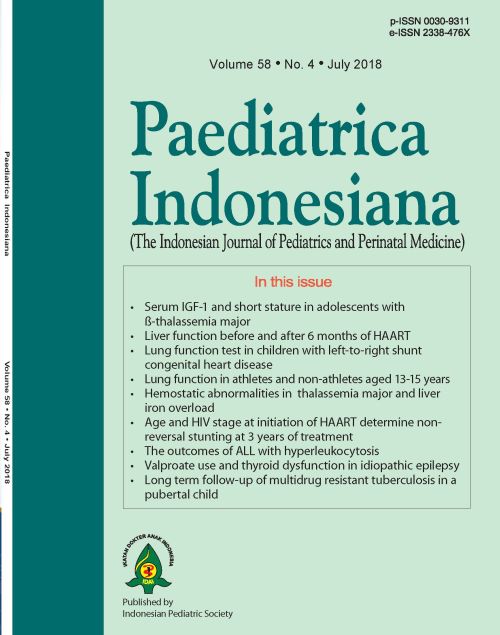Lung function test in children with left-to-right shunt congenital heart disease
DOI:
https://doi.org/10.14238/pi58.4.2018.165-9Keywords:
congenital heart disease, L to R shunt, spirometry, lung function, childrenAbstract
Background Increased pulmonary blood flow may lead to abnormal lung function in children with left-to-right (L to R) shunt congenital heart disease. This condition has been linked to considerable mortality and morbidity, including reduced lung function.
Objective To assess for lung function abnormality in children with L to R shunt congenital heart disease.
Methods We conducted a cross-sectional study involving children aged 5-18 years and diagnosed with L to R shunt congenital heart disease at Dr. Sardjito Hospital from March to May 2017. Subjects underwent spirometry tests to measure forced expiratory volume-1 (FEV-1), forced vital capacity (FVC), and forced expiratory volume-1 (FEV-1)/forced vital capacity (FVC).
Results Of 61 eligible subjects, 30 (49.2%) children had atrial septal defect (ASD), 25 (41%) children had ventricular septal defect (VSD), and 6 (9.8%) children had patent ductus arteriosus (PDA). Spirometry revealed lung function abnormalities in 37 (60.7%) children. Restrictive lung function was documented in 21/37 children, obstructive lung function in 11/37 children, and mixed pattern of lung function abnormality in 5/37 children. Pulmonary hypertension was found in 21 children. There was no significant difference in lung function among children with and without pulmonary hypertension (P=0.072).
Conclusion Abnormal lung function is prevalent in 60.7% of children with L to R shunt congenital heart disease, of which restrictive lung function is the most common. There was no significant difference in lung function among children with and without pulmonary hypertension.
References
2. Sastroasmoro S. Dasar diagnosis dan tatalaksana penyakit jantung anak. Jakarta: Perhimpunan Kardiologi Anak Indonesia; 1998. p. 1-14.
3. ten Harkel ADJ, Takken T. Exercise testing and prescription in patients with congenital heart disease. Int J Pediatr. 2010;2010:1–9.
4. Rossouw B. Balancing the heart and the lungs in children with large cardiac shunts. CME. 2013;31:16–21.
5. Kung GC, Triedman JK. Pathophysiology of left-to-right shunts - UpToDate [Internet]. 2017; [cited 2017 Oct 25]. Available from: https://www.uptodate.com/contents/pathophysiology-of-left-to-right-shunts?source=search_result&search=left to right shunt&selectedTitle=1~150.
6. Jat KR. Spirometry in children. Prim Care Respir J. 2013;22:221–9.
7. Healy F, Hanna BD, Zinman R. Pulmonary complications of congenital heart disease. Paediatr Respir Rev. 2012;13:10–5.
8. Alonso-Gonzalez R, Borgia F, Diller GP, Inuzuka R, Kempny A, Martinez-Naharro A, et al. Abnormal lung function in adults with congenital heart disease: prevalence, relation to cardiac anatomy, and association with survival. Circulation. 2013;127:882–90.
9. Sari NK, Soetadji A, Kosim MS. Hubungan antara besarnya defek septum ventrikel dengan fungsi paru. Sari Pediatr. 2014;16:189–94.
10. Miller MR, Hankinson J, Brusasco V, Burgos F, Casaburi R, Coates A, et al. Standardisation of spirometry. Eur Respir J. 2005;26:319–38.
11. Johnson JD, Theurer WM. A stepwise approach to the interpretation of pulmonary function tests. Am Fam Physician. 2014;89:359–66.
12. Yau KI, Fang LJ, Wu MH. Lung mechanics in infants with left-to-right shunt congenital heart disease. Pediatr Pulmonol. 1996;21:42–7.
13. Ginde S, Bartz PJ, Hill GD, Danuran MJ, Biller J, Sowinski J, et al. Restrictive lung disease is an independent predictor of exercise intolerance in the adult with congenital heart disease. Congenit Heart Dis. 2013;8:246–54.
14. Pianosi PT, Johnson JN, Turchetta A, Johnson BD. Pulmonary function and ventilatory limitation to exercise in congenital heart disease. Congenit Heart Dis 2009;4:2–11.
15. Sulc J, Andrle V, Hruda J, Hucín B, Samánek M, Zapletal A. Pulmonary function in children with atrial septal defect before and after heart surgery. Heart. 1998;80:484–8.
16. Janda S, Shahidi N, Gin K, Swiston J. Diagnostic accuracy of echocardiography for pulmonary hypertension: a systematic review and meta-analysis. Heart. 2011;97:612–22.
Downloads
Published
How to Cite
Issue
Section
License
Authors who publish with this journal agree to the following terms:
Authors retain copyright and grant the journal right of first publication with the work simultaneously licensed under a Creative Commons Attribution License that allows others to share the work with an acknowledgement of the work's authorship and initial publication in this journal.
Authors are able to enter into separate, additional contractual arrangements for the non-exclusive distribution of the journal's published version of the work (e.g., post it to an institutional repository or publish it in a book), with an acknowledgement of its initial publication in this journal.
Accepted 2018-06-28
Published 2018-07-27


















